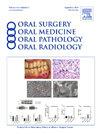Aggressive (epithelioid) osteoblastoma camouflaged by pain associated with erupting third molars—case report and literature review
IF 2
3区 医学
Q2 DENTISTRY, ORAL SURGERY & MEDICINE
Oral Surgery Oral Medicine Oral Pathology Oral Radiology
Pub Date : 2025-02-04
DOI:10.1016/j.oooo.2024.11.022
引用次数: 0
Abstract
Clinical Presentation
A 16-year-old patient was referred for extraction of third molars and supernumerary tooth distal of #17, as he had been experiencing pain in the left mandible. The pain persisted for more than 2 weeks after extraction of #17. Although the extraction site demonstrated good initial healing, there was evidence of significant bony expansion lingually with mobile #18 and 19. This had shown significant progression since the preoperative examination. A panoramic study showed resorption of distal root #19. Cone beam computed tomography scan was performed and showed a large, expansile, ill-defined, mixed density but predominantly radiolucent lesion. In addition, disruption of the lingual cortex and superior border of inferior alveolar canal was observed with no signs of paresthesia clinically.
Differential Diagnosis
Expansile bone tumors of jaw with resorption would include cemento-ossifying fibroma, osteoblastoma and osteosarcoma.
Diagnosis and Management
Histopathologic examination revealed an epithelioid neoplasm consisting of clusters of round epithelioid cells surrounding blue lace-like bony trabeculae (osteoid). Cytomorphology was bland and mitoses were occasionally seen. A diagnosis of aggressive (epithelioid) osteoblastoma was rendered. Management involved en-bloc resection with wide margins as epithelioid osteoblastoma has a high recurrence rate of almost 50%.
Conclusions
Aggressive (epithelioid) osteoblastoma, a rare histological subtype of osteoblastoma, shows a tendency for local invasion and high recurrence rate. Few cases have been reported in the jaws, with the mandible more commonly affected than the maxilla. The presence of pain from the emerging third molar and subtle clinical and radiologic evidence before extraction were the culprits which the lesion was not initially detected. Otherwise, the intense clinical expansion following extraction, location, and radiographic characteristics of this case appear to be consistent with the cases reported in the literature. Closely follow-up is recommended to monitor possible recurrence.
求助全文
约1分钟内获得全文
求助全文
来源期刊

Oral Surgery Oral Medicine Oral Pathology Oral Radiology
DENTISTRY, ORAL SURGERY & MEDICINE-
CiteScore
3.80
自引率
6.90%
发文量
1217
审稿时长
2-4 weeks
期刊介绍:
Oral Surgery, Oral Medicine, Oral Pathology and Oral Radiology is required reading for anyone in the fields of oral surgery, oral medicine, oral pathology, oral radiology or advanced general practice dentistry. It is the only major dental journal that provides a practical and complete overview of the medical and surgical techniques of dental practice in four areas. Topics covered include such current issues as dental implants, treatment of HIV-infected patients, and evaluation and treatment of TMJ disorders. The official publication for nine societies, the Journal is recommended for initial purchase in the Brandon Hill study, Selected List of Books and Journals for the Small Medical Library.
 求助内容:
求助内容: 应助结果提醒方式:
应助结果提醒方式:


